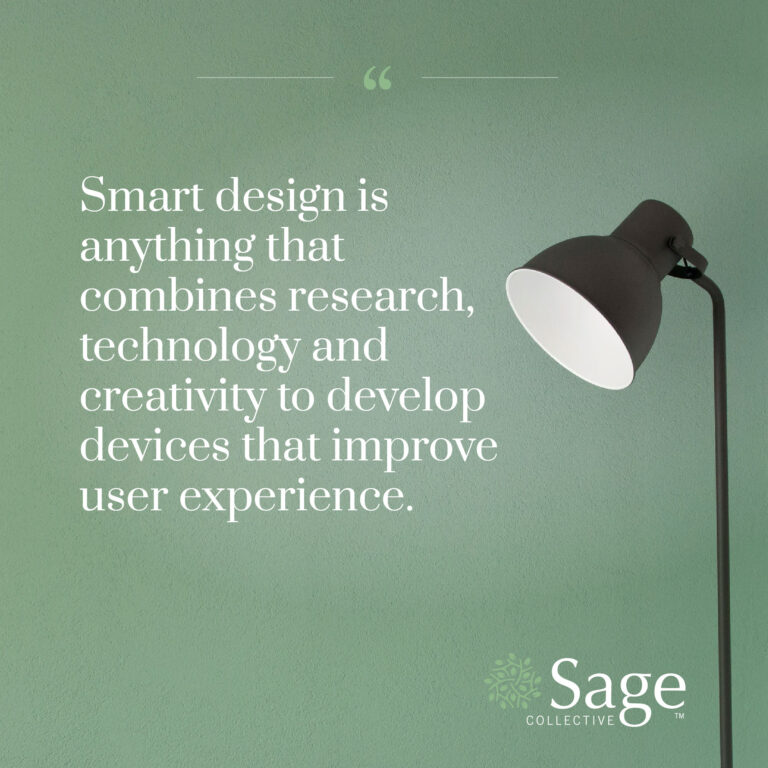Understanding the Role of Smart Design in Our Lives
As a leader in older adult living, Sage Advice prides itself on cultivating an extensive library of knowledge on relevant trends and best practices in the field of senior living and wellness. One such trend, smart design, is a uniquely adaptable, constantly evolving concept that grows with new findings daily. Today, we’re exploring what exactly smart design is, what role it plays in older adults’ lives and how its unique adaptability makes it suitable for any home.
What is it and who is it for?
Smart design is anything that combines research, technology and creativity to develop devices that improve user experience. Although a prevalent tool used to provide solutions for older adults, smart design is not limited to one specific age group — it is just coincidental that many challenges smart design seeks to address are ones that come with age.
Smart design is employed in private residences and communal homes alike. In both, smart design (which often involves smart technology) creates an environment that is safer and more accessible for its residents, often focusing on challenging areas such as kitchens and bathrooms. Design solutions can be as simple as installing grab bars or shower benches, or as complex as wearable, data-tracking technology.
Ultimately, resident (and caregiver) preferences determine which smart design solutions are a best fit for each unique situation. Everyone’s physical, cognitive, financial and emotional needs vary, and smart design solutions can be made custom to match.
The end goal
Meanwhile, why we pursue smart design is quite nuanced. Smart design seeks to address a broad continuum of unique challenges: from basic physical safety and functionality needs, to more high level goals such as mental wellbeing and the ability to flourish and be happy in one’s environment.
Smart design pursues these end results in a triage-like manner. In following the hierarchy of needs, safety needs are always the first to be addressed. If a person is not fundamentally safe in their environment, nothing else matters initially. Once those safety needs are met, then concerns can move up the scale to address things such as mental wellness. At this stage, it becomes a question of how smart design can enhance a person’s quality of life, from their ability to remain connected and engaged to even how their environment influences their self-image.
Smart design, technology and the future
Naturally, smart design evolves in parallel with technology. These days, smart design can do everything from remotely controlling lighting to providing video surveillance to utilizing data sensors to predict fall risks or other health factors. The ability of smart design tech to transfer information to caretakers streamlines many previously archaic processes and provides increased security and protection — but with it comes potential privacy concerns.
Voice-activated smart technology (like Amazon Echo and Alexa) can provide increased capability and convenience. Smartphone assistants like Siri also give access to incredibly handy apps able to assist with shopping, banking and making appointments. While this technology has benefits, it is not without its challenges. Some smart design users are tech averse and prefer not to go this route, while for others still this type of tech is inaccessible or unaffordable. There are also concerns that a person’s reliance on tech can potentially decrease their independence.
When looking towards the future of smart design, these will be the field’s biggest challenges: retaining balance, and overcoming issues of equity and spatial justice. But in the world of smart design, where every solution is person-specific, that flexibility provides degrees of freedom and space for inventive thought as we continually seek how to live our best lives — and support best lives for others.
As Sage Collective continues to pursue its mission of building a vibrant, affordable housing campus on Chicago’s South Side, smart design will become integral to our vision of comfortable, convenient and inclusive homes. Whether a resident of our future community or a follower of our vibrant living manifesto, we’ll always champion best-in-class knowledge and practices to be shared with our audience.

